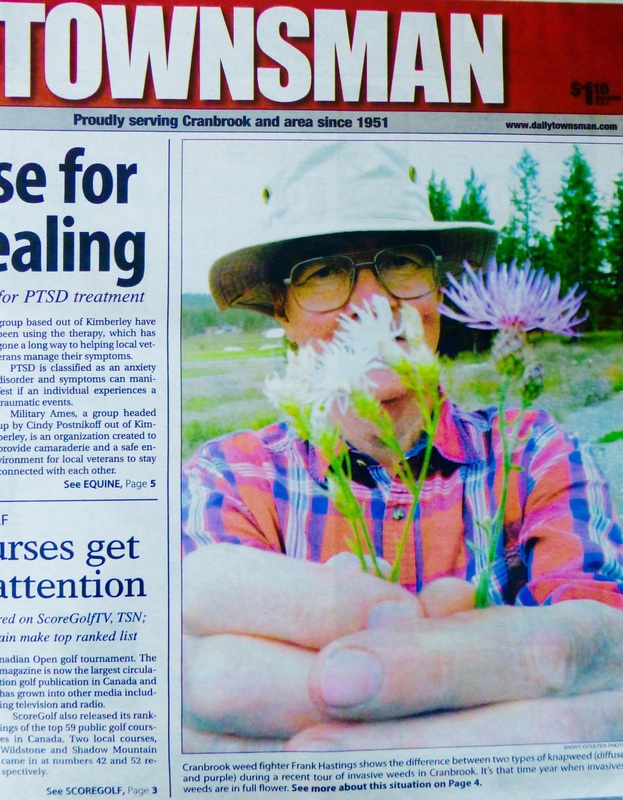Frank Hastings, who has been working for a contractor hired by the City of Cranbrook and private businesses to eradicate weeds in targeted areas, recently conducted a tour for the botanically minded, to see land where the weeds have been allowed to thrive and others where they have been cleaned out.
Earlier that day, Hastings and two others spent two hours pulling weeds out along a 100-metre stretch of Mission Road. Eleven giant garbage bags of weeds were the result, which were taken to the dump later. “Eleven garbage bags in two hours by three guys,” Hastings said. “I challenge city crews to beat that!”
Many weed species are in full flower and going to seed: a who’s who of invasive flora, some species which has been growing in the area for decades, some only recently arrived.
And of all these unwelcome aliens, these colonizing visitors, knapweed is the king.
Hastings explains that knapweed can suck water deep out of the ground with its taproot, so it can prosper in drought conditions. Each knapweed plant can produce 40,000 seeds per plant — “So with that number of seeds, it’s success rate doesn’t have to be very high.”
Knapweed also puts a chemical into the ground — catechin — which inhibits the germination of the seeds of other species. Knapweed is almost a super-species — a super-invasive species.
“Because it’s Eurasian in origin,” Hastings said, “It’s not considered food by wildlife or livestock.” He added that some local ranchers have been training their cattle to eat knapweed, introducing it into their diet so they get a taste for it.”
Right now, the best main window for controlling the invasives is past. By and large all the species are in flower, and whether humans like them or not, the bees love them. So herbicides can no longer be used without causing harm to bee populations.
Hastings says that the best combat is still the most labour intensive — pulling the weeds out by hand.
Mowing is another option, especially early on, which prevents the weeds from flowering and going to seed, and also starves the roots. Judicious application of herbicide during the two-month window of June and July is also effective. But pulling remains the best option.
The vacant property between Elizabeth Lake and the highway, where the water slides used to be, is a vast field of knapweed and other invasives including dalmation toadflax, curled dock, common tansy, burdock and mullein (which weed contractors generally leave alone, as its seeds provide food for birds). There are also tall clusters of sweet clover, which is not considered invasive and is generally left alone.
Hastings said because of the proximity of Elizabeth Lake and Jim Smith Creek, spraying is less of an option — no herbicide can be put down with 15 metres of a body of water. The best recourse, he says, is to have teams of weed pullers hit the field and pull up the weeds by hand.
In this regard, Hastings said, a recent idea of the City of Cranbrook to train teams of summer students to pull weeds is a good idea. “What I’d start doing is mowing and bagging the flower stalks, then pulling and bagging stems and roots.”
Driving along Cobham Road to the industrial section of Cranbrook, Hastings points out how clean and weed-free the roadsides are. High traffic industrial areas are City priorities for weed eradication, and businesses like Fiorentino Contracting and Tundra Steel make the effort to clean weeds out of their properties.
But out along Industrial Road G on the way out of town is the field where the stock car race track used to be — another expanse of knapweed — both spotted knapweed (purple flowers) and diffuse knapweed (white flowers), along with species like blueweed, sow thistle and goats beard, proliferate. Hastings shows a plant with short stems and yellow flowers — yellow gum weed. “It’s not listed as invasive yet,” he says, “but it’s been coming in fast.”
The big empty city-owned lot by Save-On Foods is mostly clean, except for the area used to dump snow in winter. A lot of the city’s gravel trucks used for hauling away snow will be carrying weed seeds from the summer, and that area is covered with tall, thick-stemmed weeds, baby’s breath and hedge bind weed. Hastings shows another relative newcomer — yellow tar weed. “It’s native to the Pacific Northwest, but it’s been making its way here.”
The big industrial lots covered with invasive weeds are one thing, but Hastings is interested in more awareness of the issue among residents. “Most people wouldn’t know an invasive weed if it hit them,” he said.
Property owners could contribute by learing to identify different invasive species and how to eradicate them.
Article first published in the Cranbrook "Townsman", July 30, 2015

 RSS Feed
RSS Feed
